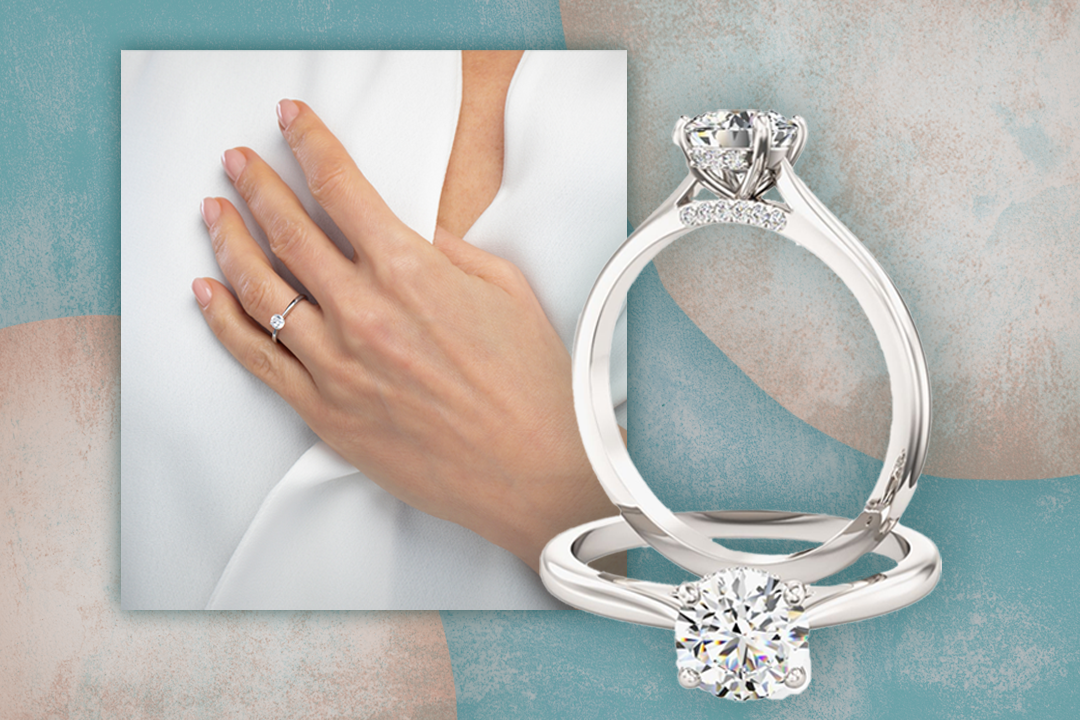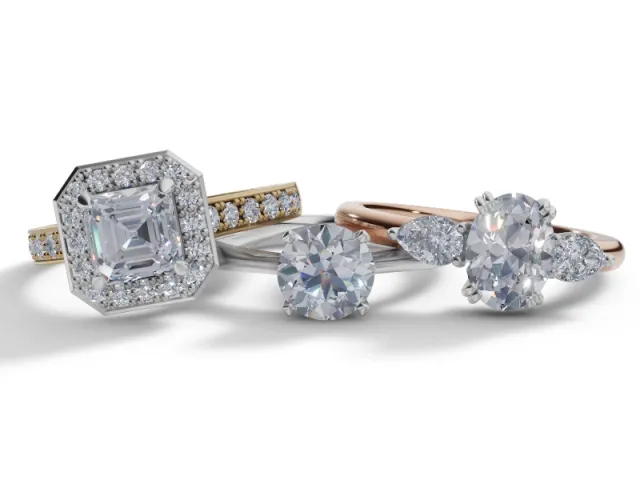Last updated on November 3, 2025
That’s when I realised something surprisingly simple: ring sizing isn’t universal. If you’ve ever tried to order jewellery online, you might’ve run into the same confusion — US sizes, UK letters, European millimetres — it’s enough to make your head spin. So today, let’s dive into what tallas de anillos España en cm actually means, how to measure your own ring size correctly, and why it’s worth understanding before you buy (especially if you’re shopping for something as special as an engagement ring).
Table of Contents
The Basics: What Does “Tallas de Anillos España en cm” Mean?
In Spain, ring sizes are measured in millimetres — specifically, the inner circumference of the ring. That means if your ring size is 54, it’s because the inside of the ring measures 54 millimetres around.
It’s quite logical when you think about it. While other countries use letters (like the UK) or arbitrary numbers (like the US), Spain’s system is clean, simple, and based on real physical measurement — the kind you can actually check at home with a bit of string or paper.
So, when you see tallas de anillos España en cm, you’re looking at a conversion of those millimetres into centimetres. For instance:
- Size 50 = 5.0 cm circumference
- Size 52 = 5.2 cm
- Size 54 = 5.4 cm
- Size 56 = 5.6 cm
You get the idea. Each size increases by about 1–2 millimetres, which might sound tiny — but in ring terms, that difference can mean comfort versus frustration.
If you’re unsure where to start, there’s a handy guide on tallas de anillos España en cm that walks you through how to measure at home and compare it with European sizes. It’s surprisingly easy once you get the hang of it, and it’ll save you a lot of awkward resizing later.
Why It’s So Easy to Get Wrong (and How to Avoid It)
Here’s something you might not know: your finger size can change throughout the day. Temperature, humidity, even what you’ve eaten — all these things can affect how snug a ring feels.
Try measuring your finger first thing in the morning, then again in the evening. You might notice a difference of half a size or more. That’s completely normal. It’s also why jewellers often recommend measuring when your hands are warm and relaxed — not after a workout, and definitely not when they’re cold.
And if you’re buying a ring as a surprise (which, let’s be honest, is one of the hardest gifts to get right), there are a few sneaky tricks. Borrow one of their rings (from the correct finger, ideally) and trace it on a piece of paper. Or better yet, measure the inside diameter with a ruler and use a conversion chart.
But here’s my favourite bit of advice — ask the jeweller for a resizing policy before you buy. Most reputable jewellers, especially in Europe and Australia, will offer one free resize. It’s the kind of detail that makes the buying experience much less stressful.
The Rise of Lab-Created Diamonds: A Modern Twist on Tradition
Now, while we’re on the topic of rings, there’s another shift happening in the jewellery world — and honestly, it’s fascinating to watch. The last few years have seen a quiet revolution: the rise of lab created diamonds.
You might’ve heard about them — diamonds that are grown in laboratories rather than mined from the earth. They’re physically and chemically identical to natural diamonds, yet they come with a fraction of the environmental and ethical baggage.
At first, many people were sceptical. “They’re not real diamonds,” some said. But that myth’s been pretty well debunked by now. In fact, the only reliable way to tell the difference is with specialised gemmological equipment. The sparkle, the brilliance, the hardness — it’s all there.
What’s really driving their popularity, though, is transparency. Today’s buyers (especially younger generations) want to know where their jewellery comes from, and what impact it has on the planet. And that’s where lab-grown diamonds truly shine.
If you’re considering an engagement ring or custom jewellery, you might want to explore lab created diamonds as an option. They’re often 30–40% more affordable than mined stones, meaning you can choose a larger carat or higher clarity without breaking the budget. Plus, they’re a beautiful reflection of modern values — love without compromise, sparkle without guilt.
How Spanish Ring Sizing Differs from the Rest of the World
Let’s circle back to ring sizing for a moment, because this is where things can get confusing when you’re shopping internationally.
Here’s a quick breakdown of how Spain compares:
- Spain & most of Europe: Measured by inner circumference (mm)
- UK & Australia: Measured by letters (A–Z)
- US & Canada: Measured by numbers (3–13, roughly)
- Japan: Also numerical, but follows its own scale
So, for example, a Spanish size 54 roughly equals:
- UK size N ½
- US size 7
- Inner diameter: about 17.2 mm
If you’ve ever ordered from an overseas jeweller, you’ll know how easy it is to mix these up. It’s one of those little details that can turn an exciting online purchase into a mild headache.
Many high-end jewellers now include interactive sizing charts or printable templates, which help. But honestly, the best method is still the old-fashioned one: visit a jeweller in person, get measured professionally, and jot it down somewhere safe (because trust me, you’ll forget).
Rings as Stories: Why the Right Fit Feels So Personal
It might sound sentimental, but there’s something almost emotional about finding the perfect ring size. When a ring fits just right, it becomes part of you — it doesn’t twist or pinch or slide around. It simply belongs.
I once interviewed a Madrid-based artisan who told me, “A ring that fits perfectly doesn’t just sit on your hand — it becomes your fingerprint.” I loved that. Because she was right. Rings aren’t just accessories; they’re markers of memory. Engagements, anniversaries, graduations, promises — all bound up in a small circle of metal and stone.
That’s why getting your size right matters. It’s not just about comfort; it’s about connection.
Measuring at Home: The DIY Method That Actually Works
Alright, if you’re curious (or impatient) and want to measure at home, here’s a quick method that’s surprisingly accurate.
- Grab a thin strip of paper or string.
Nothing fancy — just something flexible enough to wrap around your finger. - Wrap it snugly around the base of your finger.
Not too tight, not too loose. You want it to feel like a comfortable ring would. - Mark where the ends meet.
Then lay it flat and measure the length in millimetres. - Compare it with the Spanish size chart.
For instance, if you measure 5.4 cm (54 mm), your size is 54.
Remember to measure a few times throughout the day to make sure you’re getting a consistent result. Your morning size might be slightly smaller than your evening one — totally normal.
A Quick Word on Metal Choice (and Why It Affects Fit)
Here’s something most people don’t realise until they’ve worn a few rings: different metals feel different on the finger.
Gold, for example, has a softer, warmer touch. Platinum is heavier and denser. Titanium and tungsten are ultra-strong but less forgiving if you ever need resizing. Even the width of the band plays a part — a wide band will feel tighter than a narrow one, even if they’re technically the same size.
That’s why jewellers sometimes recommend going up half a size for thicker rings, especially men’s wedding bands or chunky statement pieces.
The Modern Love of Precision and Ethics
What I love most about today’s jewellery scene is how beautifully it balances tradition with technology.
You’ve got Spanish sizing charts that have been around for decades — classic, precise, almost old-fashioned in their logic. And then you’ve got modern marvels like lab-grown diamonds, created in plasma reactors that mimic the heat and pressure of the earth’s core.
It’s wild, really — ancient symbolism, futuristic materials, all meeting in something as simple as a ring.
And maybe that’s why so many people are drawn to this mix: it feels like a bridge between past and present, between craftsmanship and conscience.
So, What’s the Takeaway?
If there’s one thing I’ve learnt — both from personal experience and from talking with jewellers across continents — it’s this: knowing your ring size properly makes everything easier.
It saves you from costly resizing, helps you shop internationally, and gives you confidence that your jewellery will feel as good as it looks.
Take five minutes to measure, jot it down somewhere safe, and the next time you fall in love with a Spanish design (and trust me, it’ll happen), you’ll know exactly which size to click.
And if you’re still hesitating about that diamond? Maybe it’s time to look into lab-created stones. They’re not just a trend — they’re a testament to how far we’ve come in marrying beauty with responsibility.
Final Thought
At the end of the day, jewellery is about more than sparkle. It’s about meaning, craftsmanship, and how something so small can hold so much emotion. Whether you’re buying in Sydney or Seville, knowing your talla de anillo connects you to a tradition that’s both deeply personal and quietly universal.
So next time you’re browsing online and see tallas de anillos España en cm, take a moment. Grab a ruler, check your fit, and know that you’re one step closer to finding a ring that truly feels like yours.





